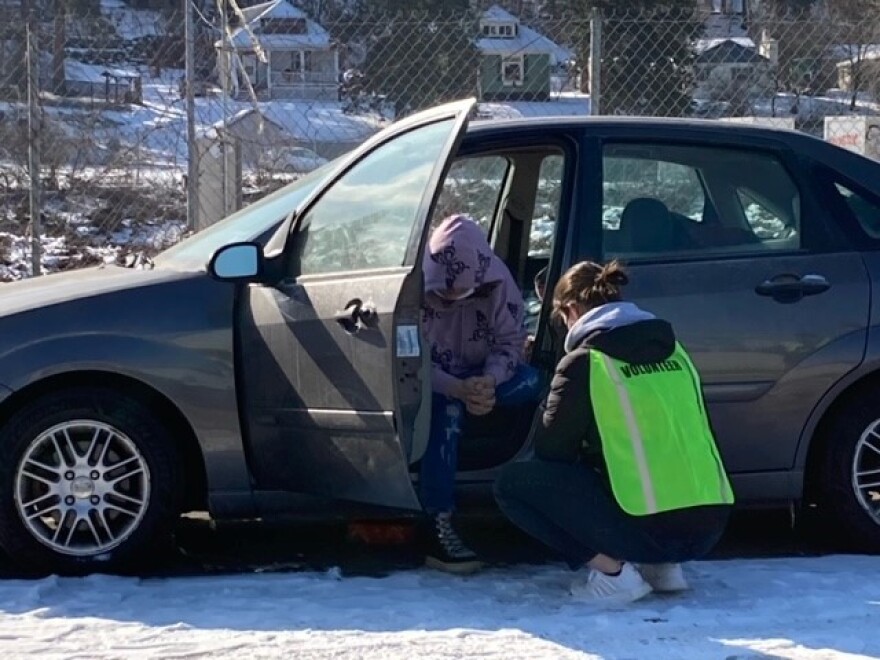Preliminary results from Spokane’s annual census of its homeless residents show a dramatic increase in people living in tents and vehicles across the county. The survey also shows a widening gulf between wages, housing prices and the cost of living in Spokane.
Since last year, real estate and rent increases have broken records. The average price of a home sale in Spokane is north of $400,000 dollars. And many renters in the city have seen rent increases on the order of several hundred dollars a month.
Those factors may have pushed more people into homelessness. Spokane’s annual point in time count found overall homelessness increased by 13 % during the pandemic. The number of people living in their vehicles or camping increased by more than 50 % since the beginning of 2020.
Eric Finch, the interim director of Neighborhoods, Housing and Human Services for the city, says data from the point in time count, as well as information gathered by city staff and researchers assisting with the count, show a connection between rising costs and homelessness.
“We were very, very affordable as a region not too many years ago and now we've kind of entered one of those segments where we're one of the more expensive areas to be, and homelessness has gone up, so there's certainty a relationship there,” Finch said, “It doesn't explain 100 percent of it, of course, but it certainly is one of the top three reasons we have the homeless challenge we have today.”
Shiloh Deitz, community data coordinator for the Spokane Public Library, says the increase in homelessness may be linked to changes in affordability. One way the city is tracking that is through the housing affordability index. It's a number that measures income and median home prices. If a community's affordability index is 100, she says that means there's a balance between incomes and housing costs.
Spokane's housing affordability index has gone from very affordable, an index of 218 in 2013 to unaffordable for the majority of county residents, around 88 at the end of 2021.
"What it really shows us, which is probably why it corresponds to the (Point In Time Count), is that for those at the lowest end of the economic spectrum, there's really kind of a squeezing out of housing affordability," Deitz said.
According to information gathered for the point in time count, Spokane’s cost of living is 6.4 % higher than the national average, while wages are $10,000 below the national average.
She says in the past, Spokane's much lower cost of living and affordable housing has acted as a cushion to the region's lower than average wages.

Eastern Washington University Professor Matt Anderson led a team of students to assist with administering and analyzing the count. He says triggering events during the pandemic and skyrocketing rents likely played a role. The region may also be seeing any issue other communities like Portland are already facing, working homelessness, where people are living out of their vehicles while working.
“If you are making the minimum, what your monthly income is like at $15 an hour, the rent would have to be $720 dollars a month for you not to be considered rent burdened, and we have looked on Zillow, Realtor.com, searching the entire market for anything on the market that is under $720 a month,” Anderson said, “Its zero. I think we found one unit, and you had to be a senior citizen (to) meet that criteria.”
Anderson says he is still waiting for more information to understand how big a role the end of the eviction moratorium played have played in homelessness trends. Anderson, and others who study homelessness, are also increasingly looking at gentrification, an increase in corporate or private equity landlords, and the disappearance of affordable and subsidized housing as larger root causes.
“The roots strike deep within the very mechanics of capitalistic housing markets,” Anderson said, “If we're not going to do enough to intervene in those mechanics and insure those who are most vulnerable have some kind of last resort to turn to prevent them from being spilled out onto the streets, then this is inevitable.”
Data from the point in time count also suggest an increase in vulnerability. People experiencing homelessness are more likely to be survivors of domestic violence than the general population. They’re also more likely to struggle with substance use or have a mental illness.
About three-quarters of the people surveyed are from Spokane County. Some others are from surrounding counties, or are from Western Washington.
Daniel Ramos III, the administrator of Spokane’s Homeless Information Management System, says those numbers also show a need for community support.
“These are folks in our community,” Ramos said. “Yeah sure, there's some who are coming from other places to here, that's something to also look at. But what can we all do as a community to support those in our neighborhood, to support those in the different groups that we're a part of, and just overall what can we do? Everyone, from the person listening to this driving in their car, to the person at work listening to the radio, or if you're actually doing this work in a shelter, how can we use this information to better improve the lives of the people that live here, who are from here.”
Ramos says a detailed breakdown of the point in time count data will soon be presented to city leaders in a public meeting. It will also be made available for the general public to review.
More information on the point and time count can be viewed here:


